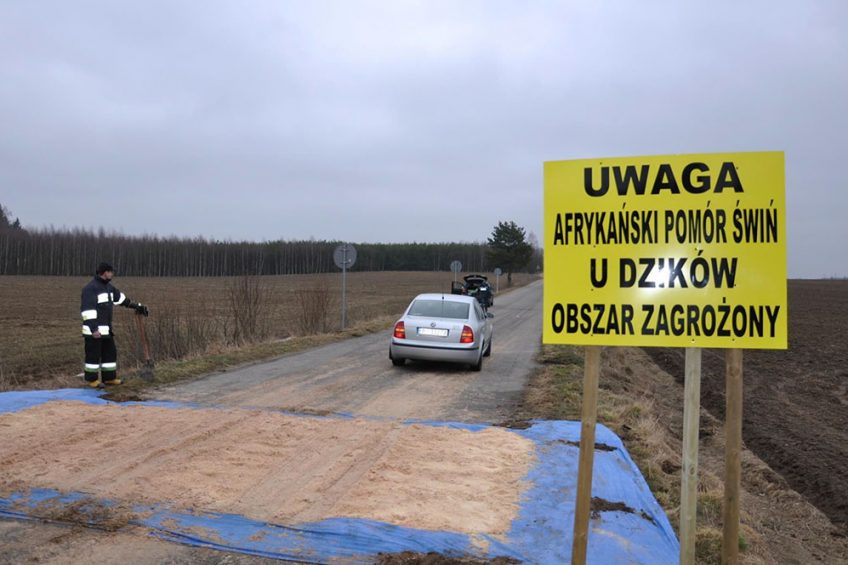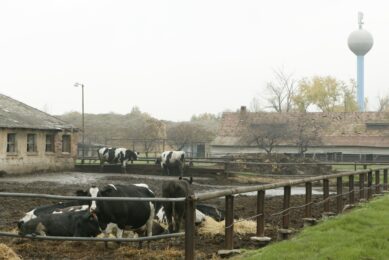ASF is a growing problem for Poland

Whereas Belgium seems to have won the battle against African Swine Fever, Poland does not seem to be able to get a grip on the virus. The number of cases in the west of the country continues to rise. For Germany, this is a reason to build a robust, permanent fence that will prevent wild boar getting in.
The African Swine Fever virus (ASFv) is well established in Poland and is a constant threat for pig production elsewhere in northwestern Europe, predominantly for Germany. Earlier this year, the virus was confirmed just over 10.5 km from the border with Germany.
Three western provinces
The virus has been in Poland since 2014, but until last year it only occurred in the east of the country. In November 2019, however, the virus was also found in the west of Poland. In the meantime, dead wild boar have been found in three western provinces, Lubusz, Lower Silesia and Greater Poland. By July 2020, the number of places where infected wild boar had been found had risen to 974, with 1,845 victims that had tested positive for the virus (see Table 1). In addition, four farms were found to be infected in western Poland by mid-July – two commercial farms and two backyard farms.
Close watch
It is quite logical that the pig industries in northwestern Europe are keeping a close watch on what is happening in Central and Eastern Europe – the economic consequences could be disastrous. As soon as the virus has been detected in a given country, the meat exports to major countries in Asia will most likely be temporarily cancelled. Only China will buy roughly 10% of pig carcasses, estimated meatpacker Vion. In the first quarter of 2020, Germany exported 730,000 tonnes of pork and by-products. Of that volume, at least 188,000 tonnes went to China. If exports to China drop for a long time, that will certainly be reflected in the pig price – and it will have a knock-on effect for the Netherlands and Denmark, for example, which both export weaner pigs to Germany.
Overwhelmed by the virus
The Polish General Veterinary Inspectorate (GVI) is responsible for fighting ASF, in both wild boar and domestic pigs. The service will deal with ASF according to the rules of the Polish authorities as well as the European Union. According to Dr Krzysztof Jażdżewski, ASF expert within the GVI, it is understandable that fighting the virus in his country does not appear to be effective, although the Czech Republic has become free of the virus and so will Belgium most likely later this year.
Poland infected at least three times from abroad
Poland, he said, has been infected at least three times from abroad, which immediately caused a lot of wild boar to be infected, spread out over a large area. Also, there has been a jump inside the country over a considerable distance twice – which led to, for example, the cluster in western Poland. Jażdżewski says that, because of the rapid and wide spread, Poland was not able to fence off a limited zone, shoot the wild boar inside that zone and conduct proper surveillance for carcasses of ASF victims, as happened in the Czech Republic and Belgium. In both those countries there was ‘spot introduction’ of the virus – an outbreak which stayed local.
ASF in one third of Polish land area
ASF is present in one third of the Polish land area. The Polish philosophy is currently focused on shooting as many wild boar as possible, preferably females. In areas with novel infections, the Polish speak of ‘intelligent hunting’. That means shooting as many wild boar as possible in the infected areas, to prevent the virus spreading. Within nine months after ASF is found in an area, hunting begins.
Search for and removal of carcasses
One other important measure is the search for and removal of carcasses of pigs that died of ASF. The military is involved with that; in addition, police, border control and fire fighters also help in the hunting. They often cover areas that are not accessible to regular hunters. Because of Covid-19, however, this external help is happening at a slower pace. Jażdżewski acknowledges that the infected area in western Poland has been growing in recent months, but emphasises that most expansion has happened towards the centre of Poland, not towards the German border.

Germany aiming for additional measures
The German authorities are not comfortable with the presence of ASF on their eastern border. A bill is ready to be sent to Germany’s parliament this autumn that will allow the construction of permanent fences to keep out wild boar. Currently two of the three states bordering Poland (Saxony and Brandenburg) have a temporary sheep fence – the case that was found 10km from the German border was close to both these states. A third state, Mecklenburg-Vorpommern, announced it would be erecting a temporary fence in July.

Track the movement of African Swine Fever
For everything you need to know about ASF, from the latest outbreaks to controls stay up to-date…
Permanent preventive fence in Saxony and Brandenburg
Both Saxony and Brandenburg advocate the construction of a permanent preventive fence. The Saxon state Ministry for Social Affairs and Cohesion, responsible for preventing the virus from entering Germany, feels that on the Polish side not a lot is happening to fight the spread of ASF.
Saxony, on the other hand, is doing quite a bit in the context of ASF spread. In the first half of the year, 5,923 wild boar were investigated for ASF presence, of which 5,538 had been shot. That is a significant increase compared to 2019, when in the entire year 9,530 wild boar were tested for ASF. Hunting and testing of wild boar is happening predominantly in the districts Bautzen and Görlitz, which border Poland and are where the virus came close this spring.
In addition, Saxony is using information and instruction campaigns to stress the risk of human behaviour introducing ASF. Hygiene measures have been installed at motorways and secondary roads to prevent the virus from being introduced.
Worries continue
Despite the care taken by the Polish veterinary services, the worries continue in the German states. Figures about ASF infections in wild boar do not paint a particularly rosy picture – after five months, the number of infected wild boar is higher than in the whole of 2019. That is to the detriment of the Polish union of pork producers. Chairman Aleksander Dargiewicz says that the Polish veterinary services are not in control of the situation – especially not when it comes to reducing ASF levels in wild boar.
Government responds slowly
The Polish pig producers (Polpig) feel the government has been responding slowly and does not listen to their advice – for instance about the necessity of building a wall at the eastern border, which Polpig has been recommending since at least 2014. Four years later, the Polish authorities did present a plan, but it is yet to be carried out. In addition, the proposal to reduce the number of wild boar drastically to 0.1 wild boar per square kilometer has not been realised – on the contrary, the number of infected wild boar has only increased. Dargiewicz states that half of the country is infected. The only positive development in his opinion is the reduction in the number of pig farms that contract ASF annually – which means that enhanced levels of biosecurity are paying off. Polish farms with 50 pigs or more were entitled to a subsidy of a maximum of € 22,350 to enhance biosecurity levels on-farm.
Poland has not won the fight yet
It is clear now that Poland has not won the fight with ASF yet. Polpig fears for the continued existence of the industry now the virus has reached the province Greater Poland, where about 36% of the national pig herd is based. The pork producers are mainly concerned about the rejected requests for compensation due to the culling of herds. Polpig says that rejection is reasonable when the pork producer has intentionally neglected biosecurity, but in all other cases it is not. Pig producers in Poland are already suffering from an enormous drop in income due to ASF – in the west this could be as high as 40%. This is mainly related to a lack of slaughter capacity in the surveillance zones, as there are transport limitations.
Surprise that ASF has not reached Germany yet
 Together with his son Erik, pig producer Erik Thijssen, aged 57, has been running a 1,600 sow farm in Grüngräbchen, a village in the German state Saxony, since 2009. He is deeply worried about the occurrence of ASF in Poland. Thijssen says, “The danger comes from Poland. Over there pig farms have been infected with the virus. We are onlookers, but we cannot do anything about it.”
Together with his son Erik, pig producer Erik Thijssen, aged 57, has been running a 1,600 sow farm in Grüngräbchen, a village in the German state Saxony, since 2009. He is deeply worried about the occurrence of ASF in Poland. Thijssen says, “The danger comes from Poland. Over there pig farms have been infected with the virus. We are onlookers, but we cannot do anything about it.”
ASF-free status
Thijssen, who used to be a pork producer in the Netherlands, does not want to think about the moment when the first ASF-infected wild boar is found in Germany. Then Germany will lose its status as an ASF-free country, and exports to lucrative markets to Asia will drop away, he says. Thijssen: “There are many wild boar over here. The wild boar that was found closest to Germany was 10 km from the border. I am still very surprised that the virus has not already reached Germany. But it can also be transferred into Germany through humans. In Poland, it suddenly jumped to the west by 400km.”
Mobile fence
Saxony placed a mobile fence along the Polish border to keep out the wild boar from Poland. Thijssen is not optimistic about the protective effects – after all, it is an electric sheep fence. In addition, there are places where humans can cross. Thijssen says, “If they want to do things well, then a permanent fence needs to be erected, just like the Danes did. On the other side, one cannot expect the Germans to close their entire eastern border. So reality has proved the authorities right.”
Plenty of food and relatively mild winters
The abundance of wild boar is due to a couple of good seasons with plenty of food and relatively mild winters. Hunters cannot be expected to shoot a lot of wild boar, Thijssen says. The majority are hobby hunters who also have regular jobs. He adds, “Politically there is no support for the shooting of a substantial amount of wild boar.”
Impact
Thijssen says that all pig farms in the vicinity of his farm have constructed a permanent fence around the farms to keep out wild boar. The animals would normally not be able to get into the direct vicinity of a farm. In Saxony state, the authorities are suggesting a stop to breeding if ASF occurs on a farm. Thijssen says, “I detest those words – I once had a similar experience in the Netherlands. In my perspective, the authorities do not understand the impact of a measure like that. But that, I suppose, is logical when one is a bit further away from the pig industry.”











